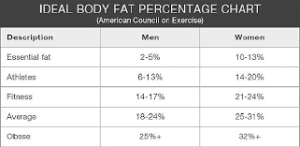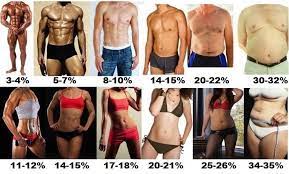
 The body fat percentage (BFP) is the total mass of fat divided by total body mass, multiplied by 100.
The body fat percentage (BFP) is the total mass of fat divided by total body mass, multiplied by 100.
Body fat includes essential body fat and storage body fat.
Essential body fat is necessary to maintain life and reproductive functions.
The percentage of essential body fat for women is greater than that for men.
Women have more body fat due to the demands of childbearing and other hormonal functions.
Storage body fat consists of fat accumulation in adipose tissue, part of which protects internal organs in the chest and abdomen.
Methods available for determining body fat percentage, measurement with calipers or through the use of bioelectrical impedance analysis.
The body fat percentage is a measure of fitness level, since it is the only body measurement which directly calculates a person’s relative body composition without regard to height or weight.
The body mass index (BMI) provides a measure that allows the comparison of the adiposity of individuals of different heights and weights.
BMI largely increases as adiposity increases, but due to differences in body composition, other indicators of body fat give more accurate results: individuals with greater muscle mass or larger bones will have higher BMIs.
BMI is a useful indicator of overall fitness for a large group of people, but a poor tool for determining the health of an individual.
The percentage of body fat in an individual varies according to sex and age.
National Health and Nutrition Examination Survey (NHANES) in the United States charts the average body fat percentages of Americans :
In males, mean percentage body fat ranges from 23% at age 16–19 years to 31% at age 60–79 years.
In females, mean percentage body fat ranges from 32% at age 8–11 years to 42% at age 60–79 years.
Women need at least 9% more body fat than men to live a normal healthy life.
Essential fat refers to the level at which physical and physiological health would be negatively affected, and below which death is certain.
The ideal body fat percentage for athletic performance is estimated at 12–18% for women and 6–15% for men.
4–6% body fat is generally considered a physiological minimum for human males.
Measurement techniques
Fat cells in humans are composed almost entirely of pure triglycerides with an average density of about 0.9 kilograms per liter.
Most laboratories use the value of 1.1 kilograms per liter for the density of the “fat free mass”.
Body density can be determined by completely submerging a person in water and calculating the volume of the displaced water from the weight of the displaced water.
There is a correction made for the buoyancy of air in the lungs and other gases in the body spaces.
Whole-body air displacement plethysmography (ADP) is a densitometric method to measure human body fat percentage.
It is based on air displacement rather than on water immersion.
Air-displacement plethysmography is
quick, comfortable, automated, noninvasive, and safe measurement process, and accommodation of various children, obese, elderly, and disabled persons.
Air-displacement plethysmography’s
accuracy declines at the extremes of body fat percentages, tending to slightly understate the percent body fat in overweight and obese persons (by 1.68–2.94%) and to overstate to a much larger degree the percent body fat in very lean subjects (by an average of 6.8%).
Near-infrared interactance uses a beam of infra-red light is transmitted into a biceps.
The light is reflected from the underlying muscle and absorbed by the fat.
Dual energy X-ray absorptiometry estimates body fat percentage, and determines body composition and bone mineral density.
Prior to the adoption of DXA, the most accurate method of estimating body fat percentage was to measure that person’s average density (total mass divided by total volume) and apply a formula to convert that to body fat percentage.
Since fat tissue has a lower density than muscles and bones, it is possible to estimate the fat content.
The bioelectrical impedance analysis (BIA) method is a lower-cost but less accurate way to estimate body fat percentage.
BIA: two or more conductors are attached to a person’s body and a small electric current is sent through the body.
The resistance between the conductors will provide a measure of body fat between a pair of electrodes, since the resistance to electricity varies between adipose, muscular and skeletal tissue.
Fat-free mass (muscle) is a good conductor as it contains a large amount of water (approximately 73%) and electrolytes, while fat is anhydrous and a poor conductor of electric current.
Factors that affect the accuracy and precision of this method include instrumentation, subject factors, technician skill, and the prediction equation formulated to estimate the fat-free mass.
Anthropometric methods for estimating body fat refers to measurements made of various parameters of the human body, such as circumferences of various body parts or thicknesses of skinfolds.
Measurements are selected, and are applied to a population sample.
From this data, a formula relating the body measurements to density is developed.
These methods are therefore inferior to a direct measurement of body density and the application of just one formula to estimate body fat percentage.
The skinfold estimation methods are based on a skinfold test, also known as a pinch test.
The skinfold test pinches of skin is precisely measured by calipers, also known as a plicometer, at several standardized points on the body to determine the subcutaneous fat layer thickness.
These measurements are converted to an estimated body fat percentage by an equation.
Ultrasound is used extensively to measure tissue structure and has proven to be an accurate technique to measure subcutaneous fat thickness.
By making thickness measurements at multiple sites on the body you can calculate the estimated body fat percentage.
Formulas exist for estimating body fat percentage from an individual’s weight and girth measurements.
Body fat can be estimated from body mass index (BMI), a person’s mass in kilograms divided by the square of the height in meters; if weight is measured in pounds and height in inches, the result can be converted to BMI by multiplying by 703.
The body fat may be estimated from the body mass index by an existing formula.
